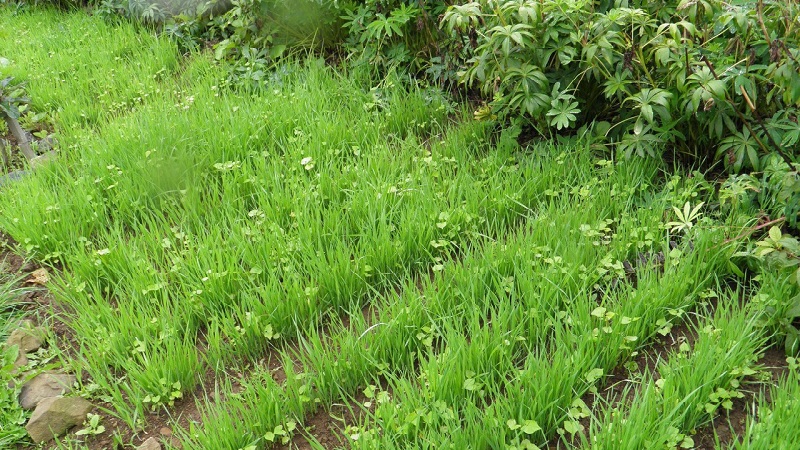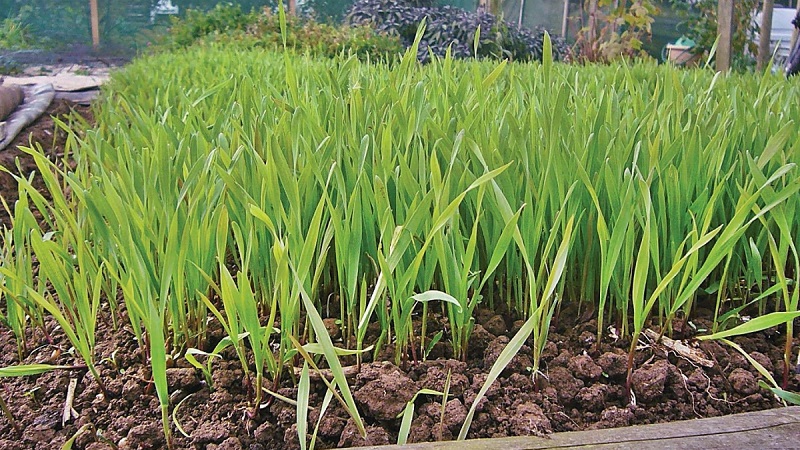Why rye is good, how green manure is in the fall and how to plant it correctly
Many gardeners consider rye to be one of the best green manures. This crop is an excellent fertilizer that can be used as an organic food for other plants. Rye is undemanding to soil, resistant to cold and drought.
However, her cultivation as siderate culture requires certain knowledge. From the article you will learn how to properly grow rye as a siderat, what are the pros and cons of this crop.
The content of the article
What gives rye as a siderat
Often winter rye as green manure is used to improve and enrich soil composition... It copes well with poorly nutritious or sandy soil and its high acidity.
Properties and effect
The main feature of winter rye is the ability to grow greens throughout the season.
In the process of decomposition of cereal sprouts, the soil is enriched with nitrogen and potassium substances. Crops subsequently planted in this land more easily assimilate and absorb hard-to-reach phosphorus compounds from the soil.

The effect of sowing rye in the fall as a green manure also lies in the fact that the soil is enriched with useful mineral components... The earth becomes lighter, looser, oxygenated and better able to retain moisture.
Rye as siderat reduces soil freezing traps more snow. This is especially important in a snowy winter.
Advantages and disadvantages of using rye as green manure
The following are noted positive qualities of rye:
- does not require special growing conditions;
- affordable;
- unpretentious, can grow on any soils: acidic, sandy, depleted;
- a branched root system allows you to extract the necessary nutrients and make them easily digestible for other plants;
- after this culture, many vegetables can be planted: potatoes, tomatoes, zucchini, cucumbers;
- repels various pests, for example, nematodes;
- destroys harmful bacteria and microorganisms;
- when planted for two years in a row as a green manure, it can suppress the growth of some weeds (birch, wheatgrass);
Among the negative moments in a cereal crop, such a property as soil drying is noted. Therefore, during a drought, be sure to water the plantings.
Important! Rye should not be planted between trees or garden crops, as this can lead to a decrease in their yield.
Do not forget about the timely harvesting of crops from the site... If the cereal is brought to earing, the greens will become coarse and very difficult to cut and chop.
What plants are suitable for
Most summer residents sow this cereal under potatoes. There are pluses here. Rye well prepares the soil for planting a vegetable... But rye roots are a favorite food wireworm - the worst enemy of potatoes. This pest also causes great harm to the vineyard.
If you nevertheless decide to plant potatoes or grapes on the site, then it is recommended to sow the cereal in a mixture with mustard or lupine.

Most ideal followers for rye: cucumbers, zucchini, tomatoes, radishes, peppers, beans, peas, pumpkin, raspberries, strawberries.
Interesting on the site:
Similarities and differences between wheat and rye in application
What are the varieties of rye: sowing, winter and other types
For which not
Since rye and other cereals have common diseases and pests, this green manure is not suitable for further sowing of all cereals, even for decorative ones.
Also rye is not planted with vegetables and fruitsas it will take up all the water and nutrients, thereby preventing other plants from developing fully.
Planting dates before winter
To improve the soil, winter rye varieties are mainly sown. This is done as the land plots are cleared. In central Russia, work is performed in three stages:
- in late August;
- at the beginning of autumn;
- at the end of September.
In the southern regions, optimal planting times winter rye - the period from mid-October to early November.
How to sow correctly
First you need to choose a site for sowing and add organic and mineral fertilizing there.
Sowing works are carried out according to the following scheme:
- all weeds and other plant residues are removed from the garden;
- the soil is slightly loosened with a hoe, if necessary, you can water;
- seeds are laid in grooves, which are located at a distance of at least 15 cm from each other; you can also scatter seeds throughout the soil in a chaotic manner.
After sowing be sure to mix the seeds with soil to prevent the birds from picking them up.
Embedment depth depends on the type of soil. For clayey - 2.5 cm, for light sandy - about 5 cm.
Seed sowing rate - 2 g per 1 sq. m. They begin to germinate at a temperature of + 2C °.
How to care
Rye is unpretentious and grows quickly, requiring little maintenance... Immediately after harvesting vegetables and fruits, this green fertilizer is sown on the beds. The culture winters calmly under the snow cover and as soon as the snow melts it immediately begins to grow.
After the appearance of green shoots rye should be watered only on particularly hot days.
If the crop grows on too poor soil, then 1-2 times per season, you can fertilize it with a nitrogen-containing fertilizer - nitrophobic, taking 20 g of the drug per 1 sq. m, or infusion of mullein. This will make the greens grow better and be juicier.
What to do with green manure
After the rye has grown, it is worth decide on methods for mulching the stems of a cereal plant... There are several options for using rye as a green manure.
Digging
Many summer residents are interested in the question of whether it is worth digging up green manure and when it is better to do it.
In March-April, the area where rye was grown is plowed... They do it immediately, as soon as the snow melts, so a sufficient amount of moisture will remain in the ground.
Attention. At least 3-4 weeks should pass between the digging of the green manure and the planting of the main plants, so that the stem and root parts of the rye have time to decompose in the ground and give their nutrients to the soil.
We cut and leave on the surface
Another use case is that the plants are mowed and left at a depth of 2-3 cm... This method is even better as it preserves the structure of the rye root system. And on the beds, natural compost gradually appears.

Most optimal moment for mowing rye - it reaches a height of 30 cm. At this time, the cereal is still young, it contains the greatest amount of nutrients.
If the rye begins to outgrow, it is also mowed and left on the soil.... They dig up the ground later, when new shoots begin to hatch.
Leave green manure until spring without mowing
Experienced farmers recommend to mow only spring and summer grass stands, and leave the autumn until spring. They are needed for snow and moisture retention.
Many gardeners use this method of sideration, as it allows better soil restoration.
Tips & Tricks
Tips from experienced farmers on the use of rye crops:
- Wait until the rye grows up and becomes prickly. By mowing these shoots, you will prepare nutritious hay for goats and cows for the winter. Thus, not only green fertilizer is obtained, but also complete animal feed.
- Rye straw can be burned to produce ash. Such fertilization is also extremely useful.It has been used for centuries both in dry form for sprinkling plants or in liquid form for feeding vegetables or fruit crops.
Reviews
Many summer residents believe that rye as a siderat is best sown in autumn... This enriches the beds with nutrient compounds just when the soil needs it most.
Vladimir, Nizhny Novgorod: “Rye suppresses weed growth until spring, unlike manure. It contains many seeds of weeds that are not digested by the gastric juice of animals and penetrate into the ground in their original form. You can get rid of them only by composting, and this takes a whole year. ".
Maria, Oryol: “Siderates sown in the fall can be embedded in the soil faster and provide an excellent green fertilizer for future plantings. Plants need about three weeks to partially decompose in the soil. ".
Mikhail, Novokuznetsk: “Nematodes and pathogenic microflora practically do not live in the places where rye grows. During the winter, the number of these pests decreases significantly. If, in addition to rye, you also plant mustard, you get a full-fledged phytosanitary fertilizer ".
Conclusion
Rye as a green manure plant improves the condition of the soil, making it softer and more moist. It also provides protection against weeds and pests. Many European countries are gradually phasing out the use of chemicals and mineral fertilizers for growing fruits and vegetables, switching to environmentally friendly ways to increase yields - green manure and bacteria.